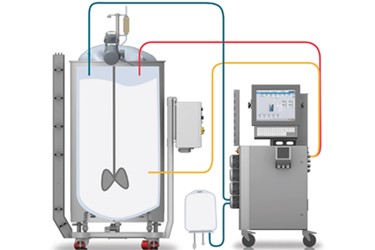Ingenious Foam Control Solutions to Enhance Your Production Processes
Ingenious Foam Control Solutions to Enhance Your Production Processes
Blog Article
Reliable Methods for Achieving Ideal Foam Control in Chemical Manufacturing
Reliable foam control is an important element of chemical production that can dramatically impact manufacturing performance and product quality. By understanding the devices of foam development and picking suitable anti-foaming agents, makers can take proactive actions to minimize excessive foam. In addition, the execution of procedure optimization methods and advanced monitoring systems plays a vital function in maintaining ideal operating conditions. The subtleties of these strategies can vary widely across various applications, raising essential inquiries regarding best techniques and real-world implementations that warrant additional expedition.
Recognizing Foam Formation

Surfactants, or surface-active agents, decrease the surface area tension of the liquid, promoting bubble security and advertising foam generation. In addition, anxiety or blending processes can enhance bubble development, commonly intensifying foam issues. The features of the liquid medium, consisting of thickness and density, additional influence foam habits; for instance, more viscous liquids have a tendency to catch air more efficiently, bring about increased foam stability.
Recognizing these basic aspects of foam development is vital for effective foam control in chemical production. By identifying the conditions that promote foam growth, makers can apply targeted methods to mitigate its negative results, consequently enhancing manufacturing processes and ensuring regular product quality. This fundamental knowledge is necessary prior to discovering certain techniques for managing foam in industrial settings.
Choice of Anti-Foaming Representatives
When picking anti-foaming agents, it is vital to think about the particular qualities of the chemical procedure and the kind of foam being generated (Foam Control). Various factors influence the performance of an anti-foaming representative, including its chemical structure, temperature security, and compatibility with various other procedure products
Silicone-based anti-foams are widely used because of their high effectiveness and wide temperature range. They function by reducing surface stress, allowing the foam bubbles to integrate and damage even more conveniently. They may not be appropriate for all applications, especially those involving sensitive formulations where silicone contamination is a concern.
On the various other hand, non-silicone representatives, such as mineral oils or natural substances, can be useful in details situations, particularly when silicone deposits are unfavorable. These representatives tend to be much less efficient at greater temperatures yet can give effective foam control in other conditions.
In addition, recognizing the foam's beginning-- whether it arises from aeration, agitation, or chain reactions-- guides the selection process. Testing under actual operating conditions is crucial to make certain that the selected anti-foaming representative meets the unique requirements of the chemical production procedure successfully.
Process Optimization Techniques
Reliable foam control is a crucial aspect of maximizing chemical manufacturing procedures. By fine-tuning these criteria, operators can lower turbulence, thus lessening foam development during blending.
Additionally, regulating Get More Info temperature and pressure within the system can substantially impact foam generation. Reducing the temperature might reduce the volatility of specific components, bring about lowered foam. Also, keeping optimal pressure levels aids in minimizing too much gas launch, which adds to foam stability (Foam Control).
Another reliable technique is the strategic enhancement of anti-foaming representatives at crucial phases of the process. Careful timing and dose can make certain that these agents properly reduce foam without interfering with other procedure parameters.
Moreover, incorporating a systematic examination of resources buildings can aid recognize inherently frothing compounds, enabling for preemptive actions. Lastly, performing regular audits and process reviews can disclose inefficiencies and areas for enhancement, allowing constant optimization of foam control strategies.
Monitoring and Control Systems
Surveillance and control systems play a critical role in maintaining optimal foam monitoring throughout the chemical manufacturing process. These systems are crucial for real-time monitoring and modification of foam levels, making certain that production effectiveness is taken full advantage of while minimizing interruptions brought on by too much foam formation.
Advanced sensing units and instrumentation are utilized to spot foam density and height, giving crucial data that educates control algorithms. This data-driven technique permits the timely application of antifoaming agents, making certain that foam degrees stay within acceptable limitations. By incorporating tracking systems with procedure control software application, suppliers can execute automatic feedbacks to foam fluctuations, decreasing the requirement for manual intervention and boosting functional consistency.
Furthermore, the combination of artificial intelligence and predictive analytics right into keeping an eye on systems can assist in positive foam administration. By assessing historic foam data and operational parameters, these systems can anticipate foam generation patterns and suggest preemptive procedures. Routine calibration and maintenance of surveillance tools are vital to guarantee accuracy and dependability in foam discovery.
Ultimately, effective surveillance and control systems are vital for enhancing foam control, advertising safety, and enhancing total productivity in chemical manufacturing atmospheres.

Instance Researches and Ideal Practices
Real-world applications of tracking and control systems highlight the importance of foam monitoring in chemical manufacturing. A remarkable study entails a large-scale pharmaceutical manufacturer that carried out an automated foam discovery system. By integrating real-time tracking with anticipating analytics, the facility lowered foam-related manufacturing downtime by 30%. The data-driven technique enabled prompt treatments, guaranteeing constant item top quality and functional performance.
An additional exemplary case originates from a petrochemical business that took on a mix of antifoam representatives and procedure optimization techniques. By examining foam generation patterns, the company click customized its antifoam dose, resulting in a 25% reduction in chemical use and significant price financial savings. This targeted strategy not just reduced foam interference yet likewise improved the overall stability of the manufacturing process.

Verdict
Finally, accomplishing ideal foam control in chemical manufacturing requires a thorough method incorporating the selection of appropriate anti-foaming representatives, execution of procedure optimization techniques, and the assimilation of advanced monitoring systems. Routine audits and training additionally improve the performance of these techniques, promoting a culture of continual enhancement. By attending to foam development proactively, suppliers can significantly improve production performance and item high quality, inevitably adding to more sustainable and cost-efficient procedures.
By understanding the mechanisms of foam formation and selecting proper anti-foaming agents, producers can take positive steps to reduce too much foam. The qualities of the fluid medium, consisting of thickness and density, more impact foam habits; for instance, even more thick liquids often tend to catch air extra successfully, leading to enhanced foam stability.
Understanding these essential elements of foam development is crucial for reliable foam control in chemical my sources manufacturing. By evaluating historical foam information and functional specifications, these systems can anticipate foam generation patterns and recommend preemptive procedures. Foam Control. Normal audits of foam control determines ensure that procedures stay enhanced, while promoting a society of proactive foam management can lead to lasting improvements throughout the production range
Report this page